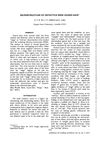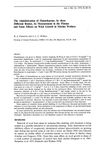Search
for
Sort by
Research
600-630 / 1000+ results
research Serum Prolactin Levels in Adult Females with Telogen Effluvium: A Case Control Study
Women with a certain type of hair loss had lower levels of a hormone called prolactin compared to healthy women.

research SEM/SDD-EDS: An Analytical Tool to Identify Waterborne Micro Minerals Pickup in Human Scalp Hair Cuticle Due to Water Quality
Water quality affects mineral content in hair, and coconut oil can protect against damage.

research Hair Anatomy for the Clinician
Understanding hair follicle anatomy helps diagnose hair disorders.

research Effects of Cooling Micrografts in Hair Transplantation Surgery
Cooling hair micrografts during transplantation does not improve their survival or growth.

research Loose Anagen Syndrome And Loose Anagen Hair
Loose Anagen Syndrome causes easy-to-pull, thin hair, mainly in young girls, and improves with age.

research Environment of the Anagen Follicle
The document concludes that hair follicles have a complex environment and our understanding of it is growing, but there are limitations when applying animal study findings to humans.

research Application of an Enzymatic Method for Identifying Hair Treatments
The enzymatic method can effectively identify chemical treatments on hair.

research Microstructure of Defective Mink Guard Hair
Defective mink guard hairs have split tips and missing cuticle cells, causing a metallic sheen.

research Hair Follicle Culture: A Historical Perspective
Advancements in hair follicle culture have led to better understanding and potential treatments for hair loss.
research Hair from Different Ethnic Groups Vary in Elemental Composition and Nitrogen and Phosphorus Mineralisation in Soil
Hair from different ethnic groups affects soil nutrient release differently.
research Understanding Curly Hair Mechanics: Fiber Strength
Curly hair is mechanically different from straight hair and may need new testing methods.
research CRISPR/Cas9-Mediated Loss of FGF5 Function Increases Wool Staple Length in Sheep
Disabling the FGF5 gene in sheep leads to longer wool.
research Intrinsic Curvature in Wool Fibres Is Determined by the Relative Length of Orthocortical and Paracortical Cells
Wool fibre curvature is due to longer orthocortical cells compared to paracortical cells.
research Wool Fibres: Sectioning and Staining, Differentiation of Ortho and Paracortex
research Reduction In Wool Follicles Prior To Birth In Merino Sheep
Merino sheep have fewer wool follicles at birth than before birth.
research Serum-Free Culture of Wool Follicles: Effects of Nutrients, Growth Factors, and Hormones
Wool follicles grew fibres for 8-10 days in a serum-free culture, influenced by calcium, glucose, amino acids, and insulin.

research The Administration of Flumethasone by Three Different Routes, Its Measurement in the Plasma, and Some Effects on Wool Growth in Merino Wethers
Flumethasone causes wool shedding in Merino wethers, with recovery in about 60 days.

research Glucose and Acetate Metabolism by Isolated Sheep Wool Follicles
Sheep wool follicles can metabolize both glucose and acetate using different pathways important for wool growth.

research Changes of Curvature with Regain of Set Wool and Hair Fibers
Merino wool fibers change shape with moisture, while human hair shape stays the same.
research Ectopic Expression of FGF5s Induces Wool Growth in Chinese Merino Sheep
Overexpression of FGF5s makes Chinese Merino sheep grow longer and heavier wool.

research The Effects of Melatonin Treatment on Wool Production and Hair Follicle Cycle in Angora Rabbits
Melatonin treatment increases wool production and improves fiber quality in angora rabbits.
research Cellular Debris in the Grease of Wool Fibers
Cellular debris sticks to damaged wool fibers and affects wool cleanliness.

research Scale Heights of Chemically Treated Wool and Hair Fibers
Chemical treatments can change the scale heights of wool and cashmere fibers, affecting their identification.
research Acid Phosphatase Distribution in the Wool Follicle: Fate of Organelles in Keratinized Cells
Keratinized wool cells still have some organelles like lysosomes and mitochondria.

research Investigation of Some Amino Acid Analogues and Metabolites as Inhibitors of Wool and Hair Growth
Certain amino acid analogues can inhibit wool and hair growth and affect fiber strength.
research The Morphological Basis of Vicuña Wool: Skin and Gland Structure in Vicugna Vicugna (Molina 1782)
Vicuña wool's quality is due to a high density of fine secondary hair follicles, and their skin glands may be used for communication.
research The Effects of Intradermal Injections of Spermidine on the Growth Rate of Fibers and Mitosis of Wool Follicles in Merino Lambs
Spermidine injections increased wool growth rate in lambs without changing fibre thickness.
research Inhibitory Effects of Ethionine, an Analogue of Methionine, on Wool Growth
Ethionine significantly inhibits wool growth in sheep but not hair growth in mice or rats.
research Effect of Topical Application of Oils of Amla, Coconut, Sarson, and Samsol on Growth of Rabbit's Hair and Sheep Wool
No clear conclusion available.